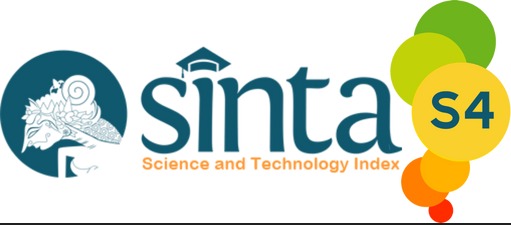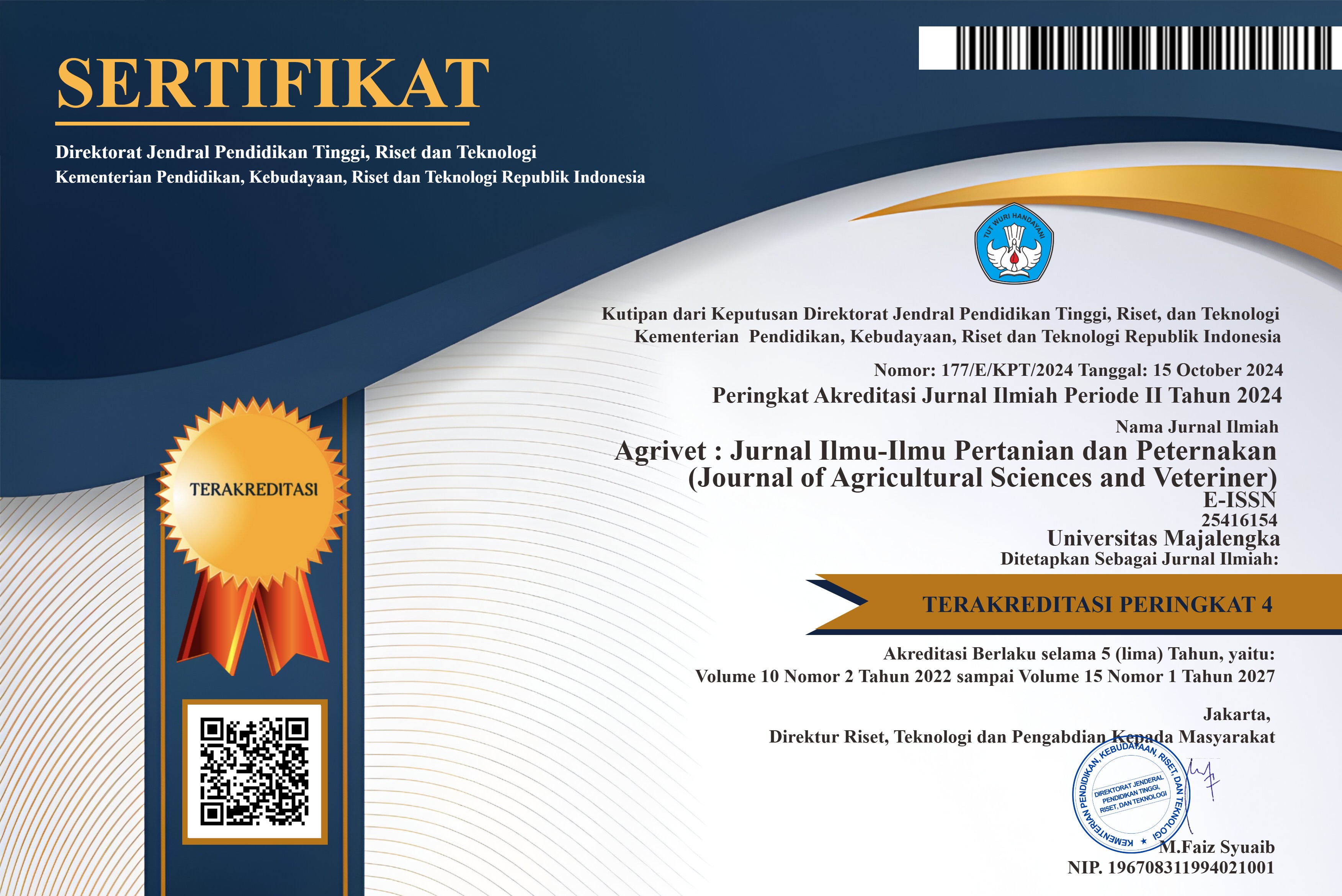Pemberian berbagai komposisi bahan organik terhadap pertumbuhan dan hasil tanaman kacang panjang (Vigna Sinensis L.) dengan sistem pertanian berkelanjutan
DOI:
https://doi.org/10.31949/agrivet.v11i2.7517Abstract
The purpose of this study was to understand the impact of optimizing organic matter and its composition on the development and productivity of long bean plants. The research was conducted from May to July 2023 at the location of Sampe Cita Village, Kutalimbaru District, Deli Serdang Regency. The method used in this study was a non-factorial randomized group design (RAK) repeated 3 times. The treatments consisted of P0 = Inorganic fertilizer (17 gr/plot N, 15 gr/plot P2O5, 15gr/plot K2O) as control. P1= Cow dung compost 1.5 kg/plot; P2= Paitan 2 kg/plot; P3= Azolla compost 1.5 kg/plot; P4= Cow dung compost 0.75 kg/plot + Paitan 1 kg/plot; P5= Cow dung compost 0.75 kg/plot + azolla compost 0.75 kg/plot; P6= Cow dung compost 0.35 kg/plot + paitan 1.5 kg/plot; P7= Cow dung compost 0.35 kg/plot + azolla compost 1 kg/plot. The findings indicated that the application of organic substances in various scenarios showed similar impacts on all growth and yield parameters. The longest average plant length for all organic matter treatments at 4 weeks after planting was found in treatment P7 (Cow dung compost 0.35 kg/plot + Azolla compost 1 kg/plot) which was 70.40 cm while at 6 weeks after planting and 8 weeks after planting was found in treatment P2 (Paitan 2 kg/plot) which was 222.98 cm and 279.04 cm. The highest number of productive branches against all organic matter treatments at 6 weeks after planting was P4 (Cow dung compost 0.75 kg/plot + Paitan 1 kg/plot) which was 5.28 branches. The highest average number of fruits per sample at 7 weeks after planting is treatment P7 (Cow dung compost 0.35 kg/plot + Azolla compost 1 kg/plot) which is 68.40 fruits, while at 8 weeks after planting and 9 weeks after planting is P2 (Paitan 2 kg/plot) which is 222.98 cm 279.04 fruits.
Keywords:
Organic Fertilizer, Azolla, Paitan, String BeansDownloads
References
Anto. (2013). Teknologi Budidaya Kacang Panjang. Penyuluhan Pertanian. BPTP.
Badan Pusat Statistik. (2018). Statistik Tanaman Sayuran dan Buah–buahan Semusim Indonesia. https://www.bps.go.id/publication/2019 /10/07/9c5dede 09c805bc38302ea.
BP3K Lubuk Pinang. (2012). Cara Budidaya Kacang Panjang. Cara Budidaya Kacang Panjang.
Faqihuddin, M. . (2011). Penggunaan Berbagai Dosis Kompos Paitan dan Pupuk Kotoran Kambing Terhadap Pertumbuhan dan Hasil Tanaman Bawang Merah (Allium ascalonicum L.).
Haryanto, E., T. Suhartini, E. R. (2012). Budidaya Kacang Panjang. Penebar Swadaya.
Hasbi, N. (2015). Pengaruh Pemberian Pupuk Nitrogen, Fosfor Dan Kalium Terhadap Pertumbuhan Dan Produksi Rumput Benggala (Panicum Maximum). Skripsi. Universitas Hasanuddin. Makassar.
Hendriyani, I. S., & Setiari, N. (2009). Kandungan klorofil dan pertumbuhan kacang panjang (Vigna sinensis) pada tingkat penyediaan air yang berbeda. Jurnal Sains & Matematika, 17(3), 145–150.
Hidayat, A., & Rosliani, R. (1996). Pengaruh pemupukan N, P, dan K pada pertumbuhan dan produksi bawang merah kultivar Sumenep. J. Hort, 5(5), 39–43.
Idawati, I., & Haryanto, H. (2001). Kombinasi Bahan Organik Dan Pupuk Inorganik Meningkatkan Hasil dan Serapan Padi Gogo.
Kurdianingsih, S., Rahayu, A., & Setyono, S. (2015). Efektivitas pupuk kalium organik cair dan tahapan pemupukan kalium terhadap pertumbuhan, produksi, dan daya simpan kacang panjang (Vigna sesquipedalis (L.) Fruhw.) kultivar KP-1. Jurnal Agronida, 1(2).
Mayun, I. A. (2007). Efek mulsa jerami padi dan pupuk kandang sapi terhadap pertumbuhan dan hasil bawang merah di daerah pesisir. Agritrop, 26(1), 33–40.
Setyamidjaja, D. (1986). Pupuk dan pemupukan. CV. Simplex. Jakarta, 122.
Published
How to Cite
Issue
Section
License
Copyright (c) 2023 Andi Setiawan, Suryani Sajar, Ihsan Proyogo

This work is licensed under a Creative Commons Attribution-ShareAlike 4.0 International License.
An author who publishes in the Jurnal Agrivet agrees to the following terms:
- Author retains the copyright and grants the journal the right of first publication of the work simultaneously licensed under the Creative Commons Attribution-ShareAlike 4.0 License that allows others to share the work with an acknowledgment of the work's authorship and initial publication in this journal
- The author is able to enter into separate, additional contractual arrangements for the non-exclusive distribution of the journal's published version of the work (e.g., post it to an institutional repository or publish it in a book) with the acknowledgment of its initial publication in this journal.
- The author is permitted and encouraged to post his/her work online (e.g., in institutional repositories or on their website) prior to and during the submission process, as it can lead to productive exchanges, as well as earlier and greater citation of the published work









